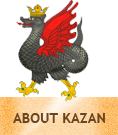Holy Dormition Monastery of Sviajsk
Address:
The Holy Dormition Monastery of Sviajsk
422500 Republic of Tatarstan,
Zelenodolsk district, island of Sviajsk
Telephone: (8-271) 3-89-50, 3-89-58

 The town of Sviajsk (nowadays a village on the island with the same name situated at the mouth of the Sviyaga River) was founded in 1551 as a fortress and a military base of the Russian troops during the war with the Kazan khanate. In the 16th
century Sviajsk was a big trading center, and in the second half of
that century it became a chief-town of the province. Though in the
following centuries Sviajsk lost its initial economic significance,
however it remains forever the first Christian town in the lands of Kazan, which revealed in the titles of archbishops and metropolitans of Kazan diocese (They were referred to as of Kazan and Sviajsk).
The town of Sviajsk (nowadays a village on the island with the same name situated at the mouth of the Sviyaga River) was founded in 1551 as a fortress and a military base of the Russian troops during the war with the Kazan khanate. In the 16th
century Sviajsk was a big trading center, and in the second half of
that century it became a chief-town of the province. Though in the
following centuries Sviajsk lost its initial economic significance,
however it remains forever the first Christian town in the lands of Kazan, which revealed in the titles of archbishops and metropolitans of Kazan diocese (They were referred to as of Kazan and Sviajsk).
In the 20th century Sviajsk underwent many severe trials. In the 1920s its monasteries and churches were ravaged and closed, and it turned into a zone of the forced labor camp. After construction of the power station of Kuibyshevsk the district of Sviyazhsk was submerged with the storage pool. Only due to the restitution and the aid provided by the Russian Orthodox Church the old town of Sviajsk succeeded in reviving.
The Monastery of the Dormition of the Most Holy Theotokos
The Dormition Monastery was founded in 1555 by Archimandrite German (Sadyrev-Polevoy), who became its first Father Superior. German, a descendant from Smolensk princes, was tonsured at the Iosif-Volokolamsk Monastery. After the repose of St. Gury, his spiritual friend, the first Archbishop of Kazan, Archimandrite German became in 1564 the second bishop of Kazan. In 1566, Tsar Ioann IV summoned Saint German to Moscow and gave orders to elect him to the Metropolitan throne there. However, Archbishop German took the side of the disgraced Metropolitan Philipp and criticized the extremities of oprichnina, which was the reason the Tsar expelled him. On November 6, 1567 he died as a victim of the epidemic of plague (according to another sources was truncated with a sword). In 1595, under the Metropolitan of Kazan Germogen (to be the next Patriarch of All Russia) the relics of Archbishop German were uncovered and he was canonized. The relics of St. German were transferred to the Dormition Monastery of Sviajsk to become the main shrine of the abode.

 In the middle of the 18th century the monastery was the most wealthy and influential among the other ones in the Kazan
diocese. It possesses 50 villages with several thousand people
(including Mamadysh village). According to the staff of 1744 it was the
first rank monastery.
In the middle of the 18th century the monastery was the most wealthy and influential among the other ones in the Kazan
diocese. It possesses 50 villages with several thousand people
(including Mamadysh village). According to the staff of 1744 it was the
first rank monastery.
In 1923, the relics of St. German so as the relics of many other saints were extracted for the purpose of atheistic propaganda. As a legend says, immediately after unsealing of St. German’s reliquary the horrible sandstorm broke out. The crowd inspired with awe scattered all around. After the profanation of the relics the monastery fell quickly into desolation and was closed.
In soviet time the monastery was converted into a forced labor camp, a jail for juvenile criminals. A psycho-neurological clinic was placed there (till 1993). The monastery estate was returned to the Russian Orthodox Church in 1997. Hegumen Kyrill (Korovin) became the first Superior of the revived monastery. His Holiness Patriarch Alexy the Second participated in the solemn ceremony of inauguration during his ministerial visit to the Kazan diocese from August 31 to September 2, 19997. There were many outstanding figures among the former father superiors of the Dormition Monastery. Avrahamy Palitsin (1594-1598) was the ecclesial writer, the distinguished political figure in the Time of Troubles. Archimandrite Dimitry (Sechenov, 1738-1742) became later on the Metropolitan of Novgorod, participated in the coronation of the Empress Catherine the Second. Archimandrite Platon (Lyubarsky, 1787-1787) was the famous historian and expert at the studies of local lore and consequently became the Metropolitan of Astrakhan. Bishop Amvrosy (Gudko, 1917-1918), the former vicar of the diocese of Vyatka, became one of the first new martyrs of the Kazan land. He was violently shot down by the soldiers of Red Army on July 27, 1918. Bishop Amvrosy was canonized in 1999. The Dormition Monastery is a unique historical and architectural complex. Nowadays some part of the monastery ensemble belongs to the community, the rest attaches to the museum-reserve of history and architecture “Sviajsk”.
St. Nicholas Church
The Church of St. Nicholas is the most ancient building on the cloistral territory. It was built in 1555-1556 out of trimmed limestone by the Pskovian team under the guidance of Ivan Shyryay. A four-tiered bell-tower with the height of 43 meters was erected in the 17th century. At the church there is the ancient cell of St. German, which preserved till the 20th century some things of the saint.
Dormition Cathedral


The Cathedral of the Dormition of the Most Holy Theotokos was built by the Pskovian craftsmen under the guidance of Postnik yakovlev and Ivan Schyryay in 1556 -1560. The refectory was attached to it in the 17th century. In the middle of the 18th century the cylindrical drum was replaced with an octahedron, whereas a helmet-shaped dome was replaced with a cupola styled in Ukrainian baroque. In the 19th century the refectory was added with a high porch. The series of murals of the 16th century, preserved till now, is one of the peculiar features of the cathedral. The frescoes were restored in the 90s of the 19th century by the painters N.M. Safonov and G.O. Chirikov under the supervision of Prof. D.V. Ainalov, the famous expert at the ancient art. From 1964 to 1984 the cathedral underwent the restoration works. The most famous frescoes are the portrayals of Tsar Ioann IV and Metropolitan Makary of Moscow depicted on the walls of the altar. The ancient iconostasis is preserved, but the icons are exhibited at the Museum of Fine Arts of the Republic of Tatarstan. At present the cathedral is undergoing the restoration works.

 At the monastery there has been preserved a two-storied building of the archimandrite’s residence, which was erected in the 17th century in the Russian tower-chambered style. From 1829 to 1858 the Sviajsk Theological School was accommodated there. In 1859 it was removed to Kazan. Besides, the buildings of monastic school (18th
century) and three fraternity buildings attaches to each other has been
left save till now. At the eastern part of those buildings there was
the Church of St. German of Kazan and St. Mitrofan of Voronezh. Nowadays these buildings have been returned to the monastery.
At the monastery there has been preserved a two-storied building of the archimandrite’s residence, which was erected in the 17th century in the Russian tower-chambered style. From 1829 to 1858 the Sviajsk Theological School was accommodated there. In 1859 it was removed to Kazan. Besides, the buildings of monastic school (18th
century) and three fraternity buildings attaches to each other has been
left save till now. At the eastern part of those buildings there was
the Church of St. German of Kazan and St. Mitrofan of Voronezh. Nowadays these buildings have been returned to the monastery.
Cathedral in honor of the Icon of the Mother of God “The Joy of All the Sorrowful”

The Cathedral in honor of the icon of the Mother of God “The Joy of All the Sorrowful” was built by design of architect F.D. Malinovsky in 1898-1906. The side-chapels were consecrated in honor of the Venerable Seraphim of Sarov and St. Anna the Prophetess. This large four-pillared crucifix shaped temple presents neo-Byzantine style combined with eclectic elements. The church was covered with fresco paintings at the expenses of Sergei Semyonovich Mechnikov, the manufacturer from Moscow. At present the cathedral is undergoing the restoration works.
St. John the Forerunner Convent (a dependency of the Dormition Monastery)
History
The convent was founded at the end of the 16th century. Initially it was located on the northwest part of the cathedral square in Sviyazhsk. After heavy conflagrations in 1753 and 1759 the convent was moved to the buildings of the monastery of the Holy Trinity and St. Sergy of Radonezh, which was founded in 1551 and abolished in 1764.
Trinity Church
The wooden Church of the Trinity is the most ancient among other orthodox temples preserved in Tatarstan. The church was built in 1551, at the same time with the fortress of Sviajsk. Though the church was reconstructed many times in the 19th century, it keeps some initial features still, except for the onion-shaped dome, which replaced the old tented dome. At the church there have been preserved wooden carved sculptures of the Savior, the Apostles, etc., which are more typical to northern regions of Russia than to the regions of the Volga River.
St. Sergius Church
The church consecrated in the name of St. Sergy of Radonezh was placed at the first floor of the refectory, which was built in 1604. The main shrine of the temple was the miracle-working icon of St.

Sergy of Radonezh. The icon was brought to Sviyazhsk in 1551. At present it is kept at the Church of the Miracle-Workers of Yaroslavl in Kazan.
Present day
On August 14, 2004 the Convent of St. John the Forerunner became a dependency of the Dormition Monastery.
The services are held every day in a full round. The works on decoration and gardening of the territory are under way.
Excursions and small groups of pilgrims are received be prior arrangement.
Community of Dormition Monastery
Superior: Hegumen Siluan (Khokhiashvilli). Dean: hieromonk Amvrosy (Lukyanov). Dwellers: hierodeacon Vikenty (Dolgopolov), hierodeacon Prokl (Kornoukhov), monk Niphont (Zhokhov), monk Makary (Medunov).
http://kazan.eparhia.ru/


